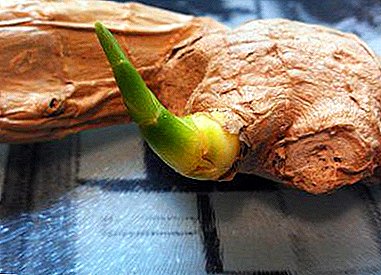 One of the most common hybrid tea roses is Double Delight. Flower growers love it for the fact that even on one bush it forms a huge variety of shades of flowers, the color of which changes as they dissolve.
One of the most common hybrid tea roses is Double Delight. Flower growers love it for the fact that even on one bush it forms a huge variety of shades of flowers, the color of which changes as they dissolve.
Description characteristics of roses Double Delight
Information about a rose Double Delight almost always begins with a description of its amazing flowers and fragrance that they exude. The bud has a classic shape, but it dissolves very slowly, changing the shades of the petals. At first they have a creamy white shade with a barely noticeable red border around the edge of the outer petals. The more a flower blooms, the more raspberry color spreads through it. During full bloom, the rose has raspberry outer petals and a creamy middle.
Important! The intensity of the color depends on the amount of light that falls on the bush. When grown in a greenhouse, where ultraviolet rays are not enough, the rose can lose its raspberry edging.
 The diameter of the flower reaches 15 cm. It itself rests on a long stem up to 70 cm in height. Usually, no more than three buds appear on one bush at a time. But even when cut, they remain fresh for a long time. Rose blooms twice a year - first in early summer, then towards the end of August. An erect branched shrub has a large, dark green foliage with a glossy surface. It is a meter in diameter, and 120 cm in height.
The diameter of the flower reaches 15 cm. It itself rests on a long stem up to 70 cm in height. Usually, no more than three buds appear on one bush at a time. But even when cut, they remain fresh for a long time. Rose blooms twice a year - first in early summer, then towards the end of August. An erect branched shrub has a large, dark green foliage with a glossy surface. It is a meter in diameter, and 120 cm in height.Did you know? The flower entered Europe from the California island of Vasco. There are several assumptions as to why the rose has the name "Double Pleasure". Some believe that because of the beautiful double color, others believe that the reason is not only beauty, but also the stunning fruity aroma of a flower, for which he received at least 30 international awards at various exhibitions.Another advantage of the variety is high frost resistance provided the use of shelters. But it doesn’t tolerate rainy summer - leaves are covered with unsightly spots.
How to choose a healthy rose seedlings when buying
If you decide that a hybrid tea double Delight rose is simply obliged to settle in your garden, you should learn how to choose its seedlings. Healthy and strong planting material - a pledge of a beautiful and sprawling bush.
First of all, pay attention to the root system of the seedling. It should be powerful, branched - this ensures a good survival rate of the plant. Make sure that there is no fungus on it, all sorts of defects. 
It is better to choose a sapling on which there are dormant buds on elastic, strong shoots. Sprouted shoots can be pinched or removed. If it has leaves, it means that the plant spends on them reserve forces and may not live to see the landing. In total, it should grow 2-3 shoots even dark green color.
Did you know? At various international exhibitions, the variety has received at least 30 international awards. The most prestigious of them - "Medal for aroma" (Ireland), "Breeders' Prize" (United Kingdom), "Gold Medal" (Italy), "America's Best Rose" (USA).The seedling should be 1-2 years old. The root neck of a strong healthy shrub has a diameter of 8-10 mm and should be the same along the entire length. It is desirable to take a sapling in a container, this will exclude damage to the roots during transportation, but in this case planting material will cost more than twice or three times.
Do not take seedlings with light shoots or pink. This suggests that the planting material was stored incorrectly, the buds sprouted without light, but warm. Considering that the root system in this state is not included in this process, the engraftment process will take a long time and is likely to end in disrepair.
Preparation of seedlings for planting
Before planting, seedlings should be kept in a cool dark place, not forgetting to moisten the roots every 10 days. When preparing seedlings for planting, first inspect them and remove dead and damaged roots, weak and broken branches. The remaining roots must be cut to a length of 30 cm. 
When spring planting, shoots are also shortened, leaving 2-3 buds on each. For early flowering, they are cut not less than 10 cm. When autumn planting, pruning should be more gentle.
If, as a result of improper storage, the roots of seedlings have noticeably dried out, they should be immersed in water for at least 12 hours. When the planting material is in critical condition it can be immersed in water completely. If it was bought in a container or in a package, do not remove it from there, pour it well. On the day of planting, the roots are immersed for two hours in water or a solution of a growth stimulator, a root-forming regulator.
Selecting a landing site: lighting and soil requirements
The two-tone rose loves well-lit areas, but with diffused light. In the shade, she loses her crimson color. But at the same time the plant does not tolerate heat. At temperatures above 30 ° C, flowers begin to curl. To prevent this, plant a rose on a well-ventilated area, but it is important that there are no drafts on it. 
Good ventilation is the key to preventing fungal diseases of the plant. Given that the rose of this variety has a well-developed root system and a spreading bush, it is necessary to plant the specimens at a distance of at least 100 cm from each other.
Important! If the rose Double Delight requires cultivation in pots, drainage should be poured generously at the bottom of the bottom so that the roots are well ventilated and do not suffer from stagnant moisture.It is impossible to grow a variety at home, as the bush grows in bulk, requires a lot of space and lighting. Any deficiency of these indicators affects the decorative characteristics of the plant.
The process and scheme of planting rose Double Delight seedlings
Before planting, the area under the rose must be dug to a depth of at least half a meter. Heavy soil is facilitated by the addition of peat or sand. It will not be superfluous to fertilize it with mineral fertilizers for roses or with humus.
Planting of seedlings is carried out in the first warm days of May, but at a temperature of about 0-7 ° C. To do this, make a hole to the height of the root, but in such a way that the root neck is 2-3 cm deep. In some cases, it is recommended to inject the graft by 5 cm after removing the wax from it. 
Important! If the root collar is left on the surface, the seedling will spoil, as the wild rose will develop.The sapling is filled with fertile soil, which is well tamped, and then watered. This will help remove excess air from the ground, and ensure that the roots fit snugly to it. After watering, it is necessary to check whether the soil is sufficiently compacted.
The bush is taken by the tops and slightly pulled up. If it is displaced, it is necessary to repeat the tamping, otherwise when rocking in the wind the plant roots are damaged, it may not settle down and die. Having well compacted the earth, from above a sapling is powdered with the damp earth so that a hill is formed. It is removed after the plant takes root - in about two weeks.
The combination of roses Double Delight with other plants
The plant survives well both in open ground in flowerbeds and in tubs. When landing on the beds, it is placed behind, planting low-growing plants in front. Herbaceous perennials will suit her company, but care must be taken that they do not grow too much, otherwise the rose may die. For cultivation in the tub pick roomy and high capacity, because the rose has long roots. 
Selecting the color of neighbors for roses, it is necessary to give preference to plants with monochromatic flowers. In the motley compositions the beauty of the flowers of this variety of roses just get lost. It should be planted with bearded irises, lily, and delphinium. Lobularia, nimerbergia, lobelia, lavender will be suitable as stunted accompanying plants.
Care and subtleties of growing a rose Double Delight
It is believed that the cultivation of roses Double Delight does not require deep knowledge in planting and caring for the plant. But still need to know their features.
How to conduct watering
The main rule of watering this variety is regularity and moderation. The variety does not like overmoistened soil, but it should not dry the earthy clod around the plant. It is watered with warm water at the rate of 5 liters for a young sapling and no less than a bucket for an adult bush. It is important that when watering water seeps down and reaches the roots. 
How to conduct dressing
It is recommended to conduct dressing of plants during watering. In the spring, when the active vegetative stage passes, nitrogen fertilizers should be used, which will help to form shoots and stimulate their growth. When the buds begin to form buds, it is worth switching to potash fertilizers.
The frequency of supplementation is once every two to three weeks. In total, a rose is fed about six times a season. As soon as the plant fades, fertilizing is excluded from its diet and begin preparing for winter.
How to prune
That in the summer on a site you would be pleased with a neat and compact rose bush, in the spring it is necessary to conduct a formative pruning. To do this, you need to pinch the young shoots, leaving them on four leaves. Then from the root will go into the growth of new shoots.
From the center of the bush must be cut weak stems and without buds. Also, make sure that shoots do not appear below the grafted bud. Such processes must be removed above the kidney in the direction of its growth.
During flowering shrub remove faded flowers. If the rainy period is turned out, it is necessary to remove flowering shoots and even unblown buds, since gray rot first appears on them. 
The second pruning is carried out in preparation for the winter. For this, the stems are cut so that no more than 40 cm of shoot remain above the ground. Just cut off those shoots that grow inside the bush.
The roots are sprinkled with peat on 30 cm, and the bush itself is covered with covering material or spruce. Until the frosts have come, do not press the shelter from below, otherwise the rose will rot. In the spring, not only shelter is removed, but also peat so that the root collar is exposed, otherwise the rose is wild.
How to deal with possible diseases and pests
The rose of this variety has some susceptibility to diseases, so it is important to carry out all the necessary preventive measures in time.
Most often, gray rot, black spot and powdery mildew appear on it. The cause of the disease is increased humidity, especially in combination with the cold. The rot appears on the flowers and buds, powdery mildew - on the leaves of the plant, which are covered with white bloom, which is why they are twisted. In the fight against these diseases help fungicides: "Floxin", "Prognosis", "Fundazol." They sprayed the plant, maintaining an interval of 2-3 weeks.
 If a rusty speckled bloom appeared on the leaves of a rose - This is a viral disease of rust, from which it is impossible to cure a rose. In this case, the bush is dug out and burned behind the plot so that the disease does not develop on the neighboring plants. For prophylaxis, the plant can be sprayed with a 3% superphosphate, and in the period before flowering, it can be treated with calcium nitrate.
If a rusty speckled bloom appeared on the leaves of a rose - This is a viral disease of rust, from which it is impossible to cure a rose. In this case, the bush is dug out and burned behind the plot so that the disease does not develop on the neighboring plants. For prophylaxis, the plant can be sprayed with a 3% superphosphate, and in the period before flowering, it can be treated with calcium nitrate.
Also pests can appear on the rose. Most often it is rosany aphid, leaflet and filer.
Aphid sticks sprouts of plants, drinking juice from them. From this they begin to curl and shrink. To get rid of the insect, the bush is sprayed with preparations "Confidor", "Karbofos", "Iskra".
Green Leaf Caterpillar damages the leaves of the rose, which curl and dry up. You can get rid of the pest by spraying the plant with “Chlorofos” or by collecting it manually.
Sawman prefers young plants. Regular loosening of the soil and its treatment with Karbofos help prevent its occurrence. If the insect does appear, you should use Actellic.
How to prepare for winter
As already mentioned, before winter, the rose bush should be cut, and the roots of the plant should be closed with peat. With strong temperature fluctuations, the roots of the plant break, and it dies. 
Also, the bush for the winter must be covered, but in this case care is needed. Often, roses die from rotting under cover, and not from frost. Therefore, until there is a strong cold, do not press the shelter to the ground. Moreover, if winter is predicted to be warm or with a large number of thaws, the bush should not be closed at all, especially if it grows on light sandy soils.
In no case can you close roses for the winter with straw, hay, manure and other similar materials, as they attract mice that dig holes under a bush. It is better to use oak leaves, fir branches, pine sawdust, peat. Before closing the plant with a film or roofing felt, it is recommended to spray it with a solution of copper sulfate - this will save it from fungal diseases.
As you can see, the care of the rose Double Delight is simple, not much different from the care of other varieties of roses. It is important to plant it in a bright place, do not overfill it, feed it in time and trim it properly. And then twice in the summer it will delight you with stunning beauty of double-colored flowers with a delicate fruity aroma.












